Mimulus
| Mimulus | |
|---|---|
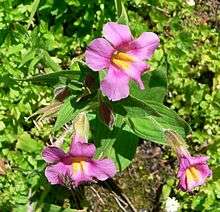 | |
| Mimulus lewisii | |
| Scientific classification | |
| Kingdom: | Plantae |
| (unranked): | Angiosperms |
| (unranked): | Eudicots |
| (unranked): | Asterids |
| Order: | Lamiales |
| Family: | Phrymaceae |
| Genus: | Mimulus L. |
| Species | |
|
Presently some 150, but see text. | |
| Synonyms | |
|
See text | |
Mimulus /ˈmɪmjuːləs/[1] is a diverse plant genus, the monkey-flowers and musk-flowers. The about 150 species are currently placed in the family Phrymaceae. The genus had traditionally been placed in Scrophulariaceae. The removal of Mimulus from that family has been supported by studies of chloroplast DNA first published in the mid-1990s. Multiple studies of chloroplast DNA and two regions of nuclear rDNA[2] suggest that the genera Phryma, Berendtiella, Hemichaena, Leucocarpus, Microcarpeae, Peplidium, Glossostigma, and Elacholoma are all derived from within Mimulus and would need to be rearranged.
It is recognized that there are two large groups of Mimulus species, with the largest group of species in western North America, and a second group with center of diversity in Australia. A few species also extend into eastern North America, eastern Asia and southern Africa. This enlarged group is a part of the newly redefined Phrymaceae.
Characteristics
Most of the species are annuals or herbaceous perennials, but a few species are subshrubs with woody stems; these are treated in the section Diplacus. Diplacus is clearly derived from within Mimulus s.l. and was not usually considered to be generically distinct. Hence, it would not be treated as a genus separate from Mimulus now, though it might become a section of a yet-to-be defined split from Mimulus s.str.. A large number of the species grow in moist to wet soils with some growing even in shallow water. Some species produce copious amounts of aromatic compounds, giving them a musky odor (hence "musk-flowers").
Mimulus are called monkey-flowers because some species have flowers shaped like a monkey's face.[3] The generic name, Latin mimus meaning "mimic actor", from the Greek mimos meaning "imitator" also references this. The stem of a few species of Mimulus can be either smooth or hairy, and this trait is determined by a simple allelic difference. At least M. lewisii is known to possess "flypaper-type" traps and is apparently protocarnivorous, supplementing its nutrients with small insects.
Uses and ecology
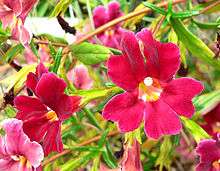
In horticulture, several species, cultivars and hybrids are used. Most important are those derived from M. bigelovii stock, a species with large, spreading flowers. One of the standard Bach flower remedies is derived from Mimulus; some species are also used in folk medicine.
Several taxa, particularly the yellow monkey-flowers (M. guttatus and relatives) and the section Erythranthe (including M. lewisii, M. cardinalis, and M. parishii) are model organisms for research in ecology, evolution, genetics and genomics.[4] The genome sequence of Mimulus guttatus was released in late spring, 2007.
Mimulus is used as food by the larvae of some Lepidoptera species, such as the Mouse Moth (Amphipyra tragopoginis) as a main part of their diet. For a list of Mimulus pathogens, see List of mimulus, monkey-flower diseases.
Edibility and medicinal uses
Mimulus species tend to concentrate sodium chloride and other salts absorbed from the soils in which they grow in their leaves and stem tissues. Native Americans and early travelers in the American West used this plant as a salt substitute to flavor wild game. The entire plant is edible, but reported to be very salty and bitter unless well cooked. The juice squeezed from the plant's foliage was used as a soothing poultice for minor burns and skin irritations.[5]
Mimulus has been listed as one of the 38 plants that are used to prepare Bach flower remedies,[6] a kind of alternative medicine promoted for its effect on health. However according to Cancer Research UK, "there is no scientific evidence to prove that flower remedies can control, cure or prevent any type of disease, including cancer".[7]
Selected species of Mimulus sensu lato
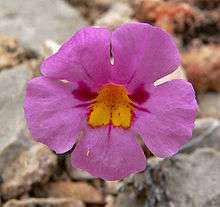

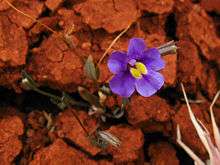
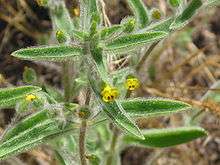

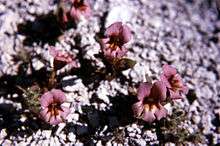
- Mimulus alatus – Sharpwing Monkey-flower
- Mimulus alsinoides – Chickweed Monkey-flower
- Mimulus androsaceus – Rockjasmine Monkey-flower
- Mimulus angustatus – Purplelip Pansy Monkey-flower
- Mimulus aridus syn. Diplacus aridus – Low Bush Monkey-flower
- Mimulus aurantiacus – Orange Bush Monkey-flower, Sticky Monkey-flower
- Mimulus bicolor – Yellow and White Monkey-flower
- Mimulus bigelovii – Bigelow's Monkey-flower
- Mimulus bolanderi – Bolander's Monkey-flower
- Mimulus breviflorus – Shortflower Monkey-flower
- Mimulus brevipes – Wide-throated Yellow Monkey-flower
- Mimulus breweri – Brewer's Monkey-flower
- Mimulus cardinalis – Scarlet Monkey-flower
- Mimulus clementii – named after Emile Clement
- Mimulus clevelandii syn. Diplacus clevelandii – Cleveland's Bush Monkey-flower
- Mimulus congdonii – Congdon's Monkey-flower
- Mimulus constrictus – (Sierra Nevada)
- Mimulus cupreus – Flor de cobre
- Mimulus cusickii – Cusick's Monkey-flower
- Mimulus dentatus – Toothleaf Monkey-flower, Coastal Monkey-flower
- Mimulus douglasii – Purple Mouse-ears, Brownies
- Mimulus evanescens – Disappearing Monkey-flower
- Mimulus exiguus – San Bernardino Mountains Monkey-flower
- Mimulus filicaulis – Slender-stemmed Monkey-flower
- Mimulus floribundus – Manyflowered Monkey-flower
- Mimulus fremontii – Frémont's Monkey-flower
- Mimulus gemmiparus – Rocky Mountain Monkey-flower
- Mimulus glabratus – Roundleaf Monkey-flower
- Mimulus glaucescens – Shieldbract Monkey-flower
- Mimulus glutinosus – Pink Monkey-flower, Hard-wooded Mimulus
- Mimulus gracilipes – Slenderstalk Monkey-flower
- Mimulus gracilis –
- Mimulus guttatus – Common Large Monkey-flower, Common Monkey-flower, Stream Monkey-flower, Seep Monkey-flower
- Mimulus hymenophyllus – Membraneleaf Monkey-flower, Thinsepal Monkey-flower
- Mimulus inconspicuus – Smallflower Monkey-flower
- Mimulus jepsonii – Jepson's Monkey-flower
- Mimulus johnstonii – Johnston's Monkey-flower
- Mimulus kelloggii – Kelloggii's Monkey-flower
- Mimulus laciniatus – Cutleaf Monkey-flower
- Mimulus latidens – Broadtooth Monkey-flower
- Mimulus layneae – Layne's Monkey-flower
- Mimulus leptaleus – Slender Monkey-flower
- Mimulus lewisii – Great Purple Monkey-flower, Lewis' Monkey-flower
- Mimulus longiflorus syn. Diplacus longiflorus – Southern Bush Monkey-flower
- Mimulus luteus – Yellow Monkey-flower, Blood-drop Emlets, Monkey Musk
- Mimulus mephiticus – Foul Odor Monkey-flower, Skunky Monkey-flower
- Mimulus michiganensis – Michigan Monkey-flower
- Mimulus mohavensis – Mojave Monkey-flower
- Mimulus montioides – Montia-like Monkey-flower
- Mimulus moschatus – Musk-flower
- Mimulus nanus – Dwarf Purple Monkey-flower
- Mimulus nudatus – Bare Monkey-flower
- Mimulus palmeri – Palmer's Monkey-flower
- Mimulus parishii – Parish's Monkeyflower
- Mimulus parryi – Annual Redspot Monkey-flower
- Mimulus peregrinus,[8][9] – Traveller Monkey-flower, Scottish Monkey-flower
- Mimulus pictus – Calico Monkey-flower
- Mimulus pilosus syn. Mimetanthe pilosa – Downy Mimetanthe
- Mimulus primuloides – Primrose Monkey-flower
- Mimulus pulchellus – Yellowlip Pansy Monkey-flower
- Mimulus pulsiferae – Candelabrum Monkey-flower
- Mimulus puniceus syn. Diplacus puniceus, now treated as Mimulus aurantiacus var. puniceus – Red Bush Monkey-flower
- Mimulus purpureus – Little Purple Monkey-flower
- Mimulus pygmaeus – Egg Lake Monkey-flower
- Mimulus rattanii – Rattan's Monkey-flower
- Mimulus repens – Creeping Monkey-flower
- Mimulus ringens – Allegheny Monkey-flower, Square-stemmed Monkey-flower
- Mimulus roseus – Rosy Monkey-flower
- Mimulus rubellus – Little Redstem Monkey-flower
- Mimulus rupicola – Death Valley Monkey-flower
- Mimulus shevockii – Kelso Creek Monkey-flower
- Mimulus sookensis[10]
- Mimulus stellatus - endemic to Cedros Island
- Mimulus suksdorfii – Suksdorf's Monkey-flower
- Mimulus tilingii – Large Mountain Monkey-flower, Tiling's Monkey-flower
- Mimulus torreyi – Torrey's Monkey-flower
- Mimulus tricolor – Tricolor Monkey-flower
- Mimulus viscidus – Viscid Monkey-flower, Sticky Monkey-flower
- Mimulus whitneyi – Harlequin Monkey-flower
References
- ↑ Sunset Western Garden Book, 1995:606–607
- ↑ Beardsley, P. M. & R. G. Olmstead. 2002. Redefining Phrymaceae: the placement of Mimulus, tribe Mimuleae, and Phryma. American Journal of Botany 89: 1093-1102.
- ↑ Coombes, A. J. 1985. Dictionary of Plant Names. Portland, Timber Press. page 119.
- ↑ Wu, C. A.; Lowry, D. B.; Cooley, A. M.; Wright, K. M.; Lee, Y. W.; Willis, J. H. (June 6, 2007). "Mimulus is an emerging model system for the integration of ecological and genomic studies". Heredity. 100 (2): 220–230. doi:10.1038/sj.hdy.6801018. ISSN 0018-067X. Retrieved 2015-05-06.
- ↑ Tilford, G. L. Edible and Medicinal Plants of the West. ISBN 0-87842-359-1
- ↑ D. S. Vohra (1 June 2004). Bach Flower Remedies: A Comprehensive Study. B. Jain Publishers. p. 3. ISBN 978-81-7021-271-3. Retrieved 2 September 2013.
- ↑ "Flower remedies". Cancer Research UK. Retrieved September 2013. Check date values in:
|access-date=(help) - ↑ Vallejo-Marin (2012). "Mimulus peregrinus" (Phrymaceae): A new British allopolyploid species. "Phytokeys" 14:1-14.
- ↑ Vallejo-Marín, Mario; Buggs, Richard J.; Cooley, Arielle M.; Puzey, Joshua R. (2015). "Speciation by genome duplication: Repeated origins and genomic composition of the recently formed allopolyploid species Mimulus peregrinus". Evolution. doi:10.1111/evo.12678. Retrieved 2015-05-10.
- ↑ Benedict, B. G., et al. (2012). Mimulus sookensis (Phrymaceae), a new allotetraploid species derived from Mimulus guttatus and Mimulus nasutus. Madroño 59(1) 29-43.
External links
| Wikimedia Commons has media related to Mimulus. |